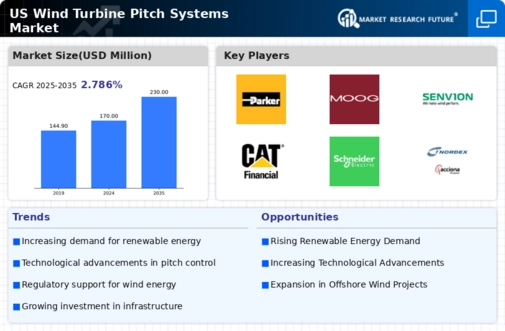Government Incentives and Tax Benefits
The wind turbine-pitch-systems market is significantly influenced by government incentives and tax benefits aimed at promoting renewable energy adoption. In the US, federal tax credits, such as the Production Tax Credit (PTC), have been instrumental in driving wind energy projects. These incentives can reduce project costs by up to 30%, making investments in wind turbine technology more appealing. As states implement their own renewable energy mandates, the demand for efficient pitch control systems is expected to rise, further stimulating market growth. This supportive regulatory environment is likely to enhance the competitiveness of wind energy in the broader energy landscape.
Rising Energy Costs and Economic Viability
The wind turbine-pitch-systems market is influenced by the rising costs of traditional energy sources, which have prompted a shift towards more economically viable alternatives. As fossil fuel prices fluctuate, the cost-effectiveness of wind energy becomes increasingly attractive. In recent years, the levelized cost of energy (LCOE) for onshore wind has dropped by over 40%, making it one of the most competitive energy sources in the US. This economic viability encourages utilities and private investors to adopt wind energy solutions, thereby driving demand for sophisticated pitch control systems that enhance turbine efficiency and energy output.
Technological Integration and Smart Grid Development
The integration of smart grid technologies is transforming the wind turbine-pitch-systems market. As the US grid evolves to accommodate renewable energy sources, the need for advanced pitch control systems becomes paramount. These systems not only optimize turbine performance but also facilitate real-time data analysis and grid stability. The US Department of Energy has indicated that smart grid investments could exceed $100 billion by 2030, highlighting the potential for growth in the wind sector. This technological synergy is likely to enhance the operational efficiency of wind farms, making pitch systems a critical component of future energy infrastructure.
Growing Investment in Renewable Energy Infrastructure
The wind turbine-pitch-systems market is experiencing a surge in investment as stakeholders recognize the potential of renewable energy infrastructure. In the US, investments in wind energy have reached approximately $20 billion annually, reflecting a robust commitment to sustainable energy solutions. This influx of capital is likely to enhance the development and deployment of advanced pitch control systems, which are crucial for optimizing turbine performance. As the demand for clean energy sources escalates, the wind turbine-pitch-systems market is poised to benefit from increased funding and technological advancements, fostering a competitive landscape that prioritizes efficiency and reliability.
Environmental Awareness and Corporate Sustainability Goals
The wind turbine-pitch-systems market is benefiting from heightened environmental awareness among consumers and corporations alike. As businesses strive to meet sustainability goals, the demand for renewable energy solutions, including wind power, is on the rise. A recent survey indicated that over 70% of US companies are prioritizing renewable energy in their corporate strategies. This shift not only drives the adoption of wind energy but also necessitates the implementation of efficient pitch control systems to maximize energy production. Consequently, the market is likely to see increased investments in technologies that support sustainable practices.





















Leave a Comment